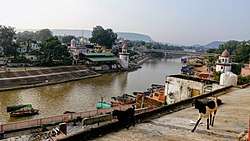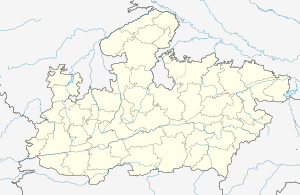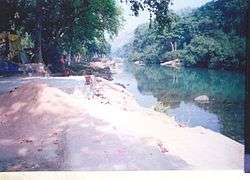Chitrakoot, Madhya Pradesh
Chitrakoot is a famous pilgrimage centre and a nagar panchayat in the Satna district in the state of Madhya Pradesh, India. It is a place of religious, cultural, historical and archaeological importance, situated in the Bundelkhand region. It borders the Chitrakoot district in Uttar Pradesh, whose headquarters Chitrakoot Dham (Karwi) is located nearby. The town lies in the historical Chitrakoot region, which is divided between the present-day Indian states of Uttar Pradesh and Madhya Pradesh. It is known for a number of temples and sites mentioned in Hindu scriptures.
Chitrakoot, Madhya Pradesh Chitrakoot | |
|---|---|
 View of ghats at Chitrakoot | |
 | |
| Coordinates: 25.00°N 80.83°E | |
| Country | India |
| State | Madhya Pradesh |
| District | Satna |
| Population (2001) | |
| • Total | 22,294 |
| Languages | |
| • Official | Hindi |
| Time zone | UTC+5:30 (IST) |
| ISO 3166 code | IN-MP |
| Vehicle registration | MP |
It attracts pilgrims throughout the year on occasions such as Amavasya, Somwati Amavasya, Deepawali, Sharad-Poornima, Makar Sankranti, Ramanavami and for Free Eye Care Medical Camps. Noted 'Ayurvedic' and 'Yoga' centres like 'Arogyadham' are located in Chitrakoot.
Geography
Chitrakoot means the 'Hill of many wonders'. Chitrakoot region falls in the northern Vindhya range spread over the states of Uttar Pradesh and Madhya Pradesh. The region is included in the District Chitrakoot of Uttar Pradesh and the District Satna of Madhya Pradesh. Chitrakoot district in Uttar Pradesh was created on 4 September 1998.[1]
Chitrakoot Parvat Mala includes Kamad Giri, Hanumaan Dhara, Janki Kund, Lakshman pahari, and Devangana famous religious mountains.
Transportation
Bamrauli airport at Allahabad is the nearest airport, 106.1 km. away from Chitrakoot, that connects Chitrakoot to the rest of India. Two regular flights of Air India serve this place, and once you touch down, you can always take up a taxi to Karwi, Chitrakoot.
Scriptural information
Chitrakoot's spiritual legacy stretches back to legendary ages. It was in these deep forests that Ram, Goddess Sita and his brother Lakshman spent eleven years and six months of their fourteen years of banishment. Great sages like Atri, Sati Anusuya, Dattatreya, Maharshi Markandeya, Valmiki and many renowned seers, devotees and thinkers meditated here and the principal trinity of the Sanatana dharma, Brahma, Vishnu and Shiva visited this place according to Hindu legends.[2]
It is said that all the gods and goddesses came to Chitrakoot when Lord Rama performed the Shraddha ceremony of his father to partake of the shuddhi (i.e. a feast given to all the relatives and friends on the thirteenth day of the death in the family). The first known mention of the place is in the Valmiki Ramayan, which is believed to be the first ever Mahakavya composed by the first ever poet. As Valmiki is said to be contemporaneous with (or even earlier than) Ram and is believed to have composed the Ramayan before the birth of Lord Ram, the antiquity of its fame can well be gauged.
Valmiki speaks of Chitrakoot as an eminently holy place inhabited by the great sages, abounding in monkeys, bears and various other kinds of fauna and flora. Both the sages Bharadwaj and Valmiki speaks of Chitrakoot in glowing terms and advise Lord Ram to make it his abode during the period of his exile. Lord Ram himself admits this bewitching impact of this place. In the Ramopakhyan and descriptions of teerths at various places in the Mahabharat, Chitrakoot finds a favoured place. In 'Adhyatma Ramayan' and Brihat Ramayan testify to the throbbing spiritually and natural beauty of Chitrakuta. Various Sanskrit and Hindi poets also have paid similar tributes to Chitrakuta. Mahakavi Kalidas has described this place beautifully in his epic Raghuvaṃśa. He was so much impressed with its charms that he made Chitrakuta (which he calls Ramgiri because of its time-honored associations with lord Ram) the place of exile of his yaksha in Meghdoot.
Tulsidas, the saint-poet of Hindi has spoken very reverently of Chitrakoot in all his major works-Ramcharit Manas, Kavitawali, Dohawali and Vinaya Patrika. The last-mentioned work contains many verses which show a deep personal bond between Tulsidas and Chitrakoot. He spent quite some part of his life here worshipping Ram and craving his darshan. It was here that he had what he must have considered the crowning moment of his achievements—i.e. the darshan of his beloved deity Lord Ram at the intercession of Hanumanji. His eminent friend, the noted Hindi poet Rahim (i.e. Abdur Rahim Khankhana, the soldier-statesmen-saint-scholar-poet who was among the Nav-Ratnas of Akbar) also spent some time here, when he had fallen from favour with Akbar's son Emperor Jahangir.[1]
Lord Ram left Chitrakoot
When Bharat was asked by his ministers to take his seat upon the throne of Ayodhya, he refused and came to Chitrakoot to meet Lord Ram. Here at place called Bharat Milap, Bharat met Lord Ram and requested him to return to Ayodhya and rule; but Lord Ram would not. Then Bharat returned to Ayodhya and installed the sandals on the throne, and, living in retirement, carried on the government as their minister. Now Lord Rama decided for two reasons to leave Chitrakuta: first, in as much as hosts of rakshasas, out of hatred of him, annoyed the hermits of that place; and, secondly, because the host of men from Ayodhya had trampled and defiled the place; and, moreover, it reminded him too sharply of brother's grief and the citizens' and queen-mothers'. He went, therefore, with Sita and Lakshmana toward Dandaka forest.[3]
Demographics
As of the 2011 Census of India Chitrakoot had a population of 23,316. Males constitute 54.36% of the population and females 45.63%, making Female Sex Ratio of 840 against state average of 931. Chitrakoot has an average literacy rate of 70.01%, lower than the national average of 74% and higher than state average 69.32%; with male literacy of 79.49% and female literacy of 58.40%. 15.72% of the population is under 6 years of age.[4]
Places of tourist importance
.jpg)
Ramghat
The ghats that line the Mandakini river are called Ramghat. During the exile period Rama, Lakshmana and Sita took bath here and are believed to have appeared before the poet Tulsidas.
Kamadgiri
Kamadgiri, the original Chitrakuta, is a place of religious significance. A forested hill, it is skirted all along its base by a chain of temples and is venerated today as the holy embodiment of Rama. Lord Rama is also known as Kamadnathji or Kamtanath which literally means fulfiller of all wishes.[5] There is a 5 km Parikrama Path around the Kamadgiri Mountain.
Bharat Milap
Bharat Milap temple is located here, marking the spot where Bharata is said to have met Rama to persuade him to return to the throne of Ayodhya. It is said that the meeting of four brothers was so emotional that even the rocks and mountains of Chitrakut melted. Foot prints of Lord Rama and his brothers were imprinted on these rocks and are still present today and seen in Bharat Milap Mandir. Bharat milap mandir is situated beside kamadgiri mountain, in the circumambulation path of kamadgiri.
Janaki Kund
Janaki Kund is situated upstream of the Ramghat where it is believed that Sita bathed in the crystal clear waters of Mandakini river during the years of her exile with Rama.
Sati Anasuya ashrama

Sati Anasuya ashrama is located further upstream, 16 km from the town, set amidst thick forests that round to the melody of birdsong all day. It was here that Atri muni, his wife Anasuya and their three sons (who were the three incarnations of Brahma, Vishnu and Mahesh), lived and are said to have meditated.
As per description of Valmiki at one time there was no rain in Chitrakuta for ten years. There was a severe famine and nothing was left to eat or drink for animals and birds. Sati Anasuya performed hard and intensive austerities and got the river Mandakini down on earth. This led to the greenery and forests to grow which removed the sufferings of all sages and the animals.[6]
Sati Anasuya ashrama at present is a very peaceful place where various streams from the hills converge and form the Mandakini River. It is said that Rama along with Sita had visited this place to meet Maharishi Atri and Sati Anasuya. It is here Sati Anasuya explained to Sita the grandeur and importance of Satitva (which means chastity; not the sati practice). The dense forests of Dandaka start from this place. It was ruled by Ravana. Ravana had appointed strong rakshasas like Khara and Viradha as its rulers. The place was infected by the terror of rakshasas.[7]
Gupt-Godavari
Gupt-Godavari is situated at a distance of 18 km from town. Here is a pair of caves, one high and wide with an entrance through which one can barely pass, and the other long and narrow with stream of water running along its base. It is believed that Rama and Lakshmana held court in latter cave, which has two natural throne-like rocks.
Pampapur
It is situated in the valley of Devangana. Sacred caves related to Lord Rama.
Hanuman Dhara
Located on a rock-face several hundred feet up a steep hillside is a spring, said to have been created by Rama to assuage Hanuman when the latter returned after setting Lanka afire. A couple of temples commemorate this spot, which offers a panoramic view of Chitrakut.
Bharat Koop
Bharath Koop is where Bharata stored holy water collected from all the places of pilgrimage in India. It is small, an isolated spot a few kilometres from the town. It has a small well and temple situated next to it. The water in the well remains pure and clean round the year. The story goes, that Bharatji came to Chitrakoot to convince Shri Ram to come back to Ayodhya, after the death of King Dasharath, to ask Shri Ram to become king of Ayodhya and rule it, thus creating Ram-Rajya. For this purpose, he also bought the waters of five rivers along with him to do Lord Shri Ram's coronation. But, Lord Ram told Bharath that he does not wish to break his vow given to King Dasharath of coming back to Ayodhya only after completing Vanvas of 14 years. Hence, Bharath asked rishi Vashisht how to use the 5 rivers water that he brought along with him for Lord Ram's Rajya Abhishek. Rishi Vashisht advised him to put all the water along with flowers he had got for Rajya-abhishek in a well specified near Chitrakoot. He explained that the water in this well will remain pure and will be revered till the end of the time. Hence, upon the advice of rishi Vashisht, king Bharath followed his instructions and thus this place was named as Bharath koop.
Ram Shaiya
This place is located on the way between Chitrakoot and Bharat Koop, in an isolated location. According to Ramayana, this is the place where Shri Ram, Sitaji and Laxmanji used to sleep and rest in the evenings after wandering around the forest of Chitrakoot. It is located between mountains with no town nearby. It has a large flat-bed rock which bears foot imprints popularly believed to be those of Shri Rama, Lakshman, and Sita Mata.
References
| Wikivoyage has a travel guide for Chitrakoot. |
- District Unit Chitrakoot, National Informatics Centre
- Vinod Avasthi: Chitrakuta darshan (Hindi), Purushotam Das Agarwal, Banda
- Sister Nivedita & Ananda K.Coomaraswamy: Myths and Legends of the Hindus and Bhuddhists, Kolkata, 2001 ISBN 81-7505-197-3
- https://censusindia.gov.in/2011census/dchb/2312_PART_B_DCHB_SATNA.pdf
- https://chitrakoot.nic.in/tourist-place/chilika-barkul-3/
- Ayodhya kanda – sarga 117 shloka 9, 10
- Ayodhya kanda – sarga 116 shloka 11, 12
6. ^ Alok Kumar: - Bhaishaundha Chitrakoot (8948057098)